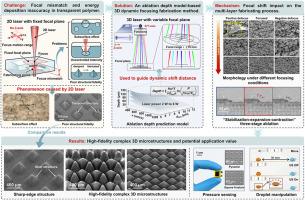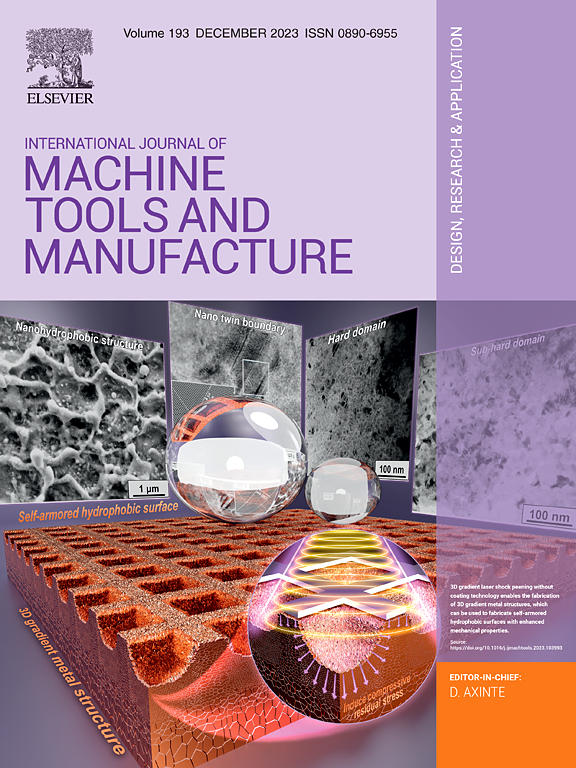模型驱动的三维激光聚焦转移在透明柔性聚合物微结构精密制造中的应用
IF 18.8
1区 工程技术
Q1 ENGINEERING, MANUFACTURING
International Journal of Machine Tools & Manufacture
Pub Date : 2025-07-12
DOI:10.1016/j.ijmachtools.2025.104310
引用次数: 0
摘要
微工程透明柔性聚合物组件在柔性电子和微流体等微系统领域发挥着至关重要的作用。然而,传统的激光制造技术在克服能量沉积不精确和焦点失配问题方面面临着重大挑战,这阻碍了在透明聚合物材料中制造高保真和可控的三维微观结构。在这项研究中,我们提出了一种使用红外皮秒激光器的通用三维动态聚焦激光器(3D- dfl)制造策略。该系统通过实时动态调整z轴聚焦,有效补偿了烧蚀引起的深度偏移,保证了能量沉积的一致性和稳定的制造质量。高速成像揭示了激光照射下的三阶段消融机制(稳定、膨胀和收缩)。为了支持3D-DFL方法的多层动态位移过程,建立了一个通用烧蚀深度预测模型,以补偿激光-材料相互作用过程中的深度偏差。该模型能够预测不同聚合物材料的烧蚀深度,平均绝对百分比误差(MAPE)较低,聚二甲基硅氧烷(PDMS)的平均绝对百分比误差为5.99%,聚对苯二甲酸乙二醇酯(PET)的平均绝对百分比误差为2.68%。该模型能够精确地制造3D微结构,实现归一化峰谷偏差在8.0%以内,归一化均方根偏差在3.0%以下,算术表面粗糙度约为2 μm。3D动态聚焦激光(3D- dfl)方法可以快速定制复杂的几何形状,包括PDMS和PET基板上的突出和凹陷微结构。实验验证强调了其制造功能组件的能力,如柔性压力传感器,微流控芯片和超声波液滴操作平台。本研究为高精度透明聚合物微工程器件的规模化制造提供了一条高效可靠的途径,促进了先进柔性微系统的研究和工业发展。本文章由计算机程序翻译,如有差异,请以英文原文为准。

Model-driven 3D laser focus shifting for precision fabrication of microstructures in transparent flexible polymers
Micro-engineered transparent flexible polymers components play a crucial role in various microsystem fields, such as flexible electronics and microfluidics. However, conventional laser fabrication techniques face significant challenges in overcoming issues of energy deposition inaccuracies and focal mismatch, which hinder the fabrication of high-fidelity and controllable 3D microstructure in transparent polymer materials. In this study, we propose a universal 3D dynamic-focusing laser (3D-DFL) fabrication strategy using an infrared (IR) picosecond laser. By dynamically adjusting the Z-axis focus in real time, the system effectively compensates for the depth shifts caused by ablation, ensuring consistent energy deposition and stable fabrication quality. High-speed imaging reveals a three-stage ablation mechanism (stabilization, expansion, and contraction) under laser irradiation. To support the multi-layer dynamic shifting process of the 3D-DFL approach, a universal ablation depth prediction model was established to compensate depth deviations during laser-material interactions. The validity of the model has been proven by its ability to predict ablation depth in different polymer materials with low mean absolute percentage errors (MAPE), achieving 5.99 % for polydimethylsiloxane (PDMS) and 2.68 % for polyethylene terephthalate (PET). The model enables the accurate fabrication of 3D microstructures, achieving normalized peak-to-valley deviations within 8.0 % and normalized root-mean-square deviations below 3.0 %, with an arithmetic surface roughness of approximately 2 μm. The 3D dynamic-focusing laser (3D-DFL) approach enables rapid tailoring of complex geometries, including protruding and recessed microstructures on PDMS and PET substrates. Experimental validation highlights its capability to fabricate functional components such as flexible pressure sensors, microfluidic chips, and ultrasonic droplet manipulation platforms. This study provides an efficient and reliable pathway for the scalable fabricating of high-precision transparent polymers micro-engineered devices and promotes the advancement of research and industry in advanced flexible microsystems.
求助全文
通过发布文献求助,成功后即可免费获取论文全文。
去求助
来源期刊
CiteScore
25.70
自引率
10.00%
发文量
66
审稿时长
18 days
期刊介绍:
The International Journal of Machine Tools and Manufacture is dedicated to advancing scientific comprehension of the fundamental mechanics involved in processes and machines utilized in the manufacturing of engineering components. While the primary focus is on metals, the journal also explores applications in composites, ceramics, and other structural or functional materials. The coverage includes a diverse range of topics:
- Essential mechanics of processes involving material removal, accretion, and deformation, encompassing solid, semi-solid, or particulate forms.
- Significant scientific advancements in existing or new processes and machines.
- In-depth characterization of workpiece materials (structure/surfaces) through advanced techniques (e.g., SEM, EDS, TEM, EBSD, AES, Raman spectroscopy) to unveil new phenomenological aspects governing manufacturing processes.
- Tool design, utilization, and comprehensive studies of failure mechanisms.
- Innovative concepts of machine tools, fixtures, and tool holders supported by modeling and demonstrations relevant to manufacturing processes within the journal's scope.
- Novel scientific contributions exploring interactions between the machine tool, control system, software design, and processes.
- Studies elucidating specific mechanisms governing niche processes (e.g., ultra-high precision, nano/atomic level manufacturing with either mechanical or non-mechanical "tools").
- Innovative approaches, underpinned by thorough scientific analysis, addressing emerging or breakthrough processes (e.g., bio-inspired manufacturing) and/or applications (e.g., ultra-high precision optics).

 求助内容:
求助内容: 应助结果提醒方式:
应助结果提醒方式:


